This post may contain affiliate links. Please read our disclosure policy.
This 5-ingredient homemade protein powder is made from wholesome seeds with no chemicals or fillers, is easy to customize, loaded with nutrients, versatile, and naturally vegan & gluten-free!
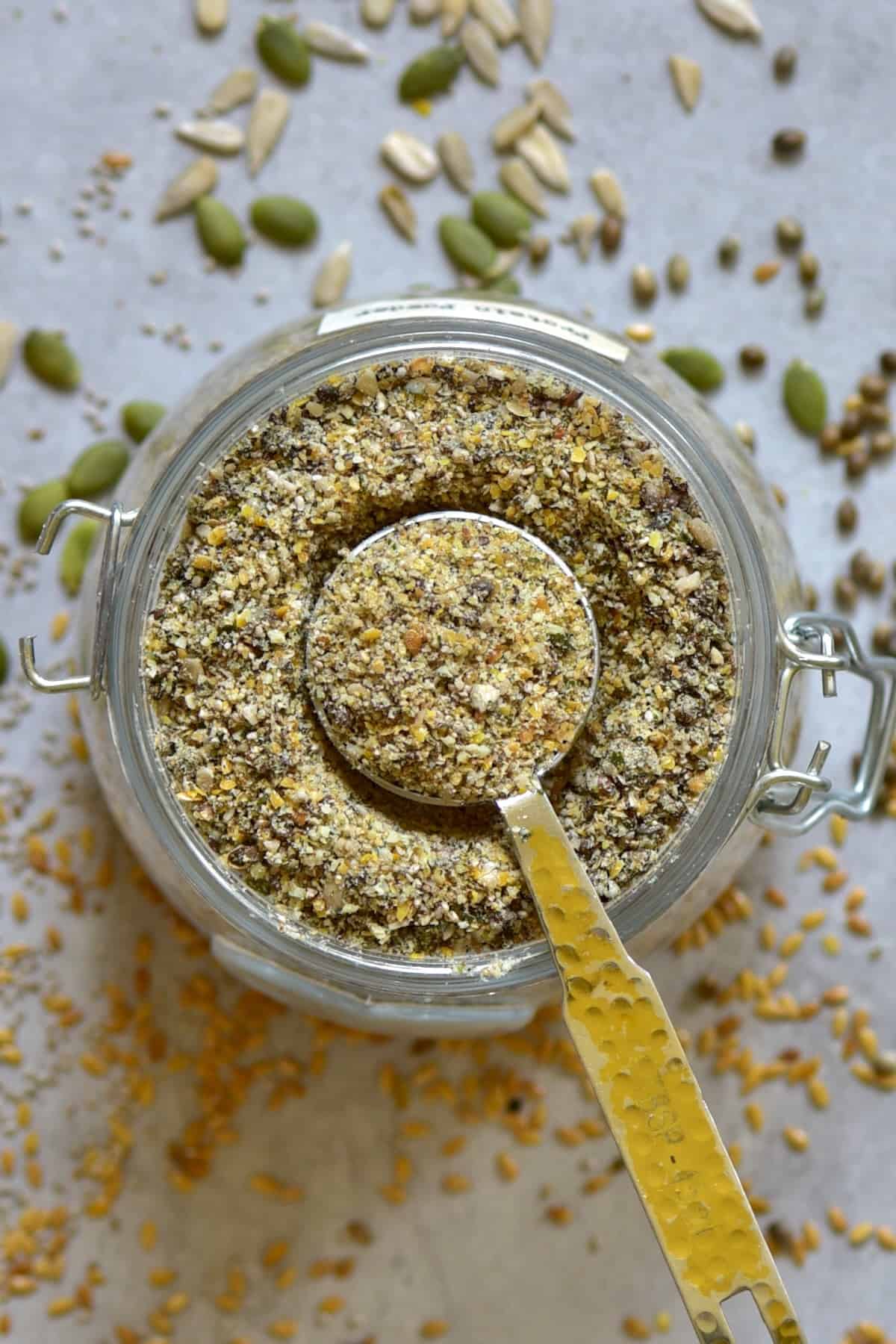
This homemade protein powder uses a blend of 5 high-protein seeds for a cheaper (especially if they’re already in your pantry), cleaner way to boost your protein with no chemicals, fillers, or gums. Just clean, high-quality ingredients, easy to customize to your dietary and flavor preferences.
Combined, this DIY vegan protein powder recipe will help keep you feeling full for longer, aid with muscle growth and tissue repair, provide a vitamin/mineral and omega boost, and several other benefits. These may include reduced inflammation and blood pressure, regulating blood sugar levels, and improved skin, brain, and heart health.
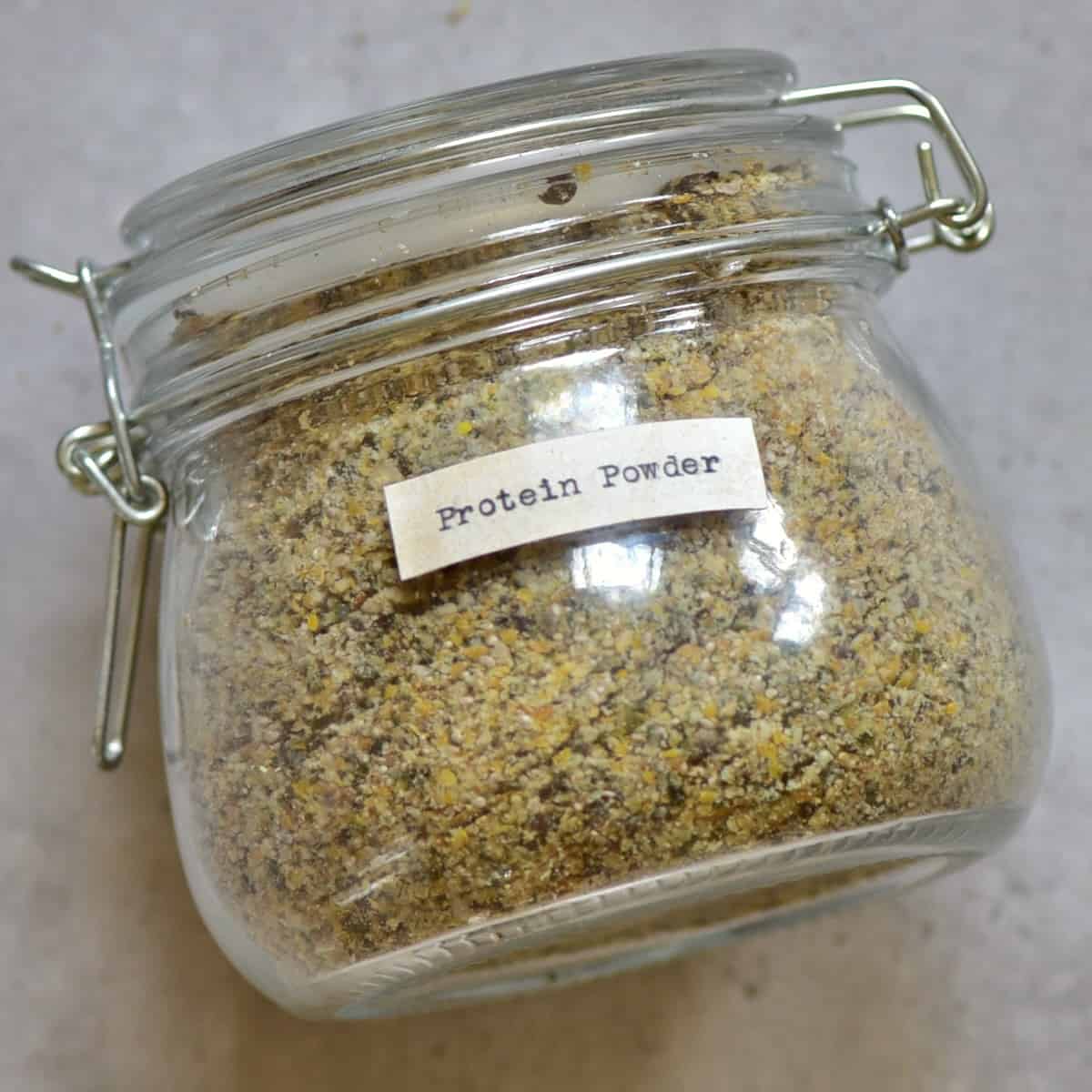
While it’s not 100% comparable to store-bought versions, this DIY protein powder is quick and simple to make and customize, will save you money, and is great to add to smoothies, post-workout shakes, baked goods, oatmeal, salads, and more!
Want to save this recipe?
Ingredients for homemade protein powder
- Hemp Seeds: Make sure to use shelled hemp seeds/ hemp hearts (the ones photographed aren’t shelled). The shells are too hard to digest. These seeds contain an optimal ratio of omega-6 to omega-3, several minerals, 30g protein per 100 grams, and are a high-quality complete source of plant-based protein.
- Chia Seeds: These tiny seeds contain 18g of protein per 100 grams, gut-healthy fiber, omega-3 fatty acids, and plenty of antioxidants.
- Flax Seeds: (aka linseed) You can use golden or brown linseed, which contain healthy omega-3s, lignans (a potent antioxidant), and about 18 g protein per 100 grams.
- Pumpkin seeds: (pepitas) These rich, green seeds contain 19g of protein per 100 grams and are a rich source of magnesium, iron, zinc, and plenty of antioxidants.
- Sunflower Seeds: Last but not least, this small but mighty seed is filled with nutrients, including a healthy dose of magnesium, potassium, zinc, iron, folate, and vitamins A, B, and E. They also contain 21-23g protein per 100g and ZERO cholesterol.
- Vanilla powder: (Optional) If you plan to serve the homemade protein powder in sweet formats only, a small amount of vanilla powder is a great way to boost flavor.
Alternatively, add 2-3 tbsp cacao powder for homemade chocolate protein powder or freeze-dried berries for a berry flavor.
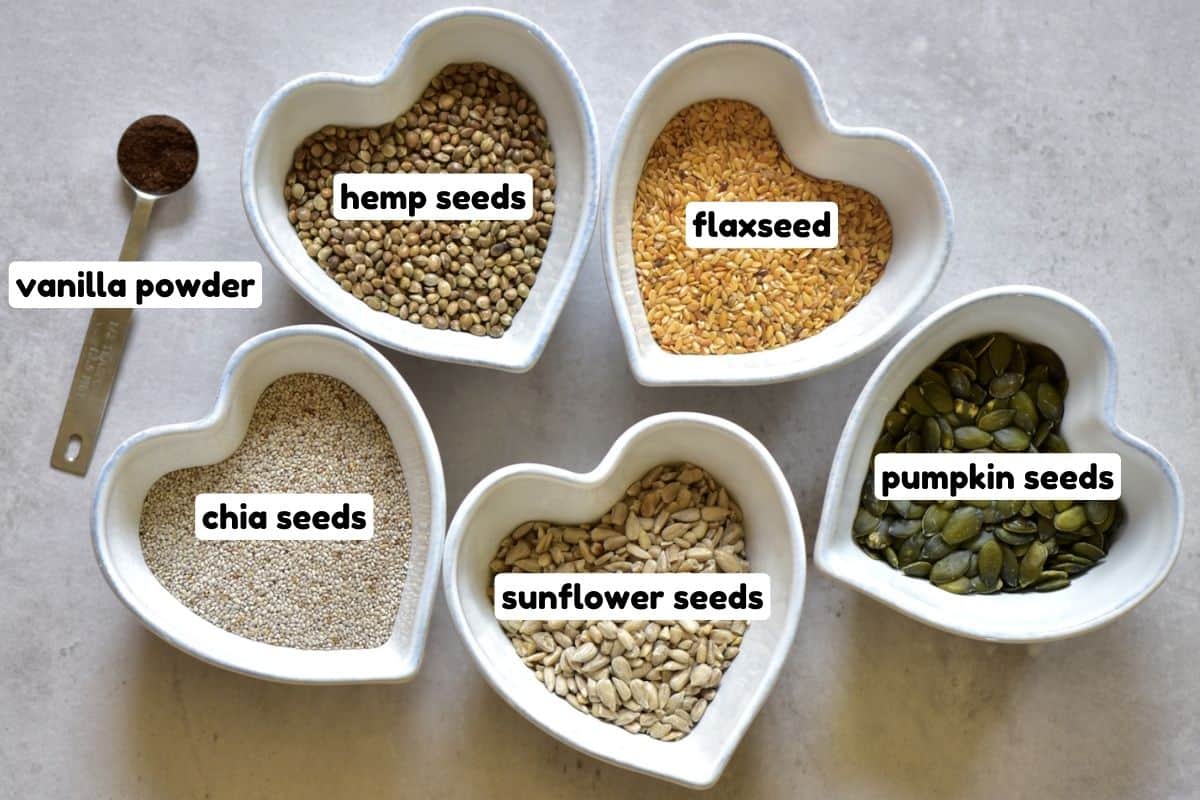
What else could I add for a protein boost?
There are several ways to customize this DIY protein powder with additional high-protein ingredients, such as:
- Peanut powder (which contains 48-49 grams of protein per 100 grams)
- Pistachios (which contain 20 g protein per 100 grams) – or cashews, walnuts, almonds
- Pea protein isolate (which contains a whopping 80-84 g protein per 100 grams)
- Whey protein isolate (dairy-based, 90 g protein per 100 grams!)
- Whey protein concentrate (usually between 70-80g protein per 100 grams)
How to make your own protein powder
Grind each seed individually in a high-speed blender or coffee/spice grinder. As a general rule:
- Hard seeds/nuts: Grind for 10-15 seconds or until you achieve a fine, powdery consistency. Pause and check the consistency to avoid over-processing them, as they can start turning into seed butter.
- Soft seeds: Grind for 5-10 seconds, and be cautious not to over-process them, or they can become gummy.
Then, transfer the protein blend to an airtight jar/container and shake/stir to combine.

Why it’s important to grind each seed separately
- For the best consistency: Just like when making nut and seed butter, different seeds have different hardness and oil levels. That means they’ll take a different amount of time to achieve the same powdery consistency. Grinding them individually allows you to ensure that you have the most consistent and even texture throughout.
- To avoid over-processing: As certain seeds, like chia and flax seeds, become gummy if over-processed – which is likely when blending everything together.
- For maximum nutrients: The longer you grind ingredients, the hotter the machine becomes, which can lead to nutrient degradation. Individual grinding ensures this is kept to a minimum. Likewise, some seeds, like flax seeds, are best if ground just before using them to preserve nutrients (their Omega-3 fatty acids) and keep them from becoming bitter too soon.
- To customize the blend: For example, the ratio within the blend, thus overall flavor and texture. That way, you can more easily experiment with various combinations and proportions. If you aren’t keen on any of the ingredients, just leave it out or swap it for something similar.
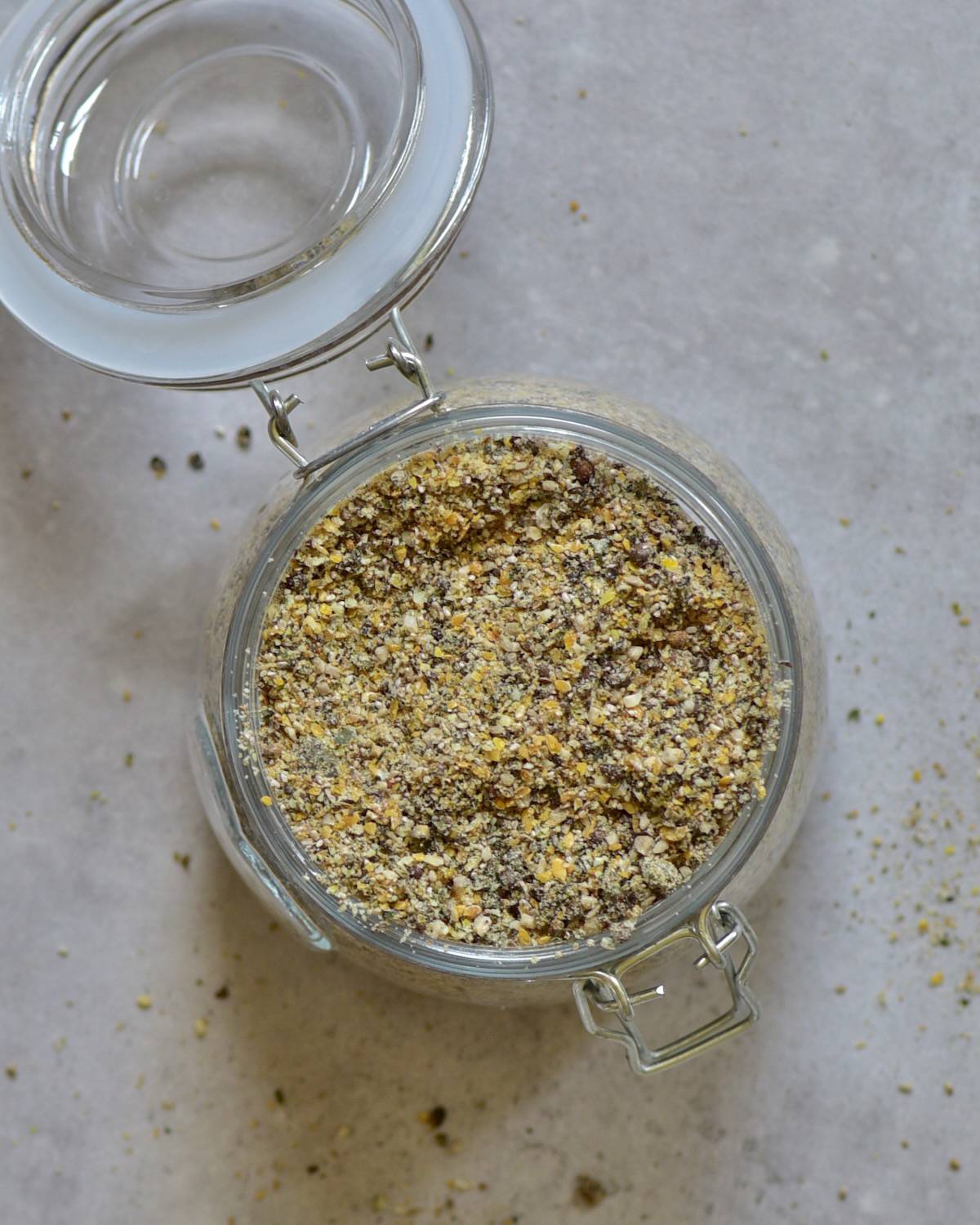
Best ways to use protein powder
This homemade vegan protein powder is great as a ‘topper’ or ‘add-in’ to boost protein content in:
- Oatmeal and overnight oats
- Smoothies, protein shakes, and smoothie bowls
- A yogurt parfait
- Over salads and soups, or in sauces (minus the vanilla)
- Sprinkled over a bagel or avocado toast
- As a topper for pancakes, waffles, and more (with berries and maple syrup)
- As a flour substitute (in small quantities) in pancakes, cookies, and quick breads
Storage instructions
Ground flaxseed/ chia seeds have the shortest shelf life due to their high oil content, which can quickly turn them rancid once ground. Combat this by only grinding them fresh or storing them separately in an airtight container in the fridge for 1 week or in the freezer for up to 3 months.
The remaining seed blend can be stored in the refrigerator for 1-2 months or in the freezer for up to 6 months.
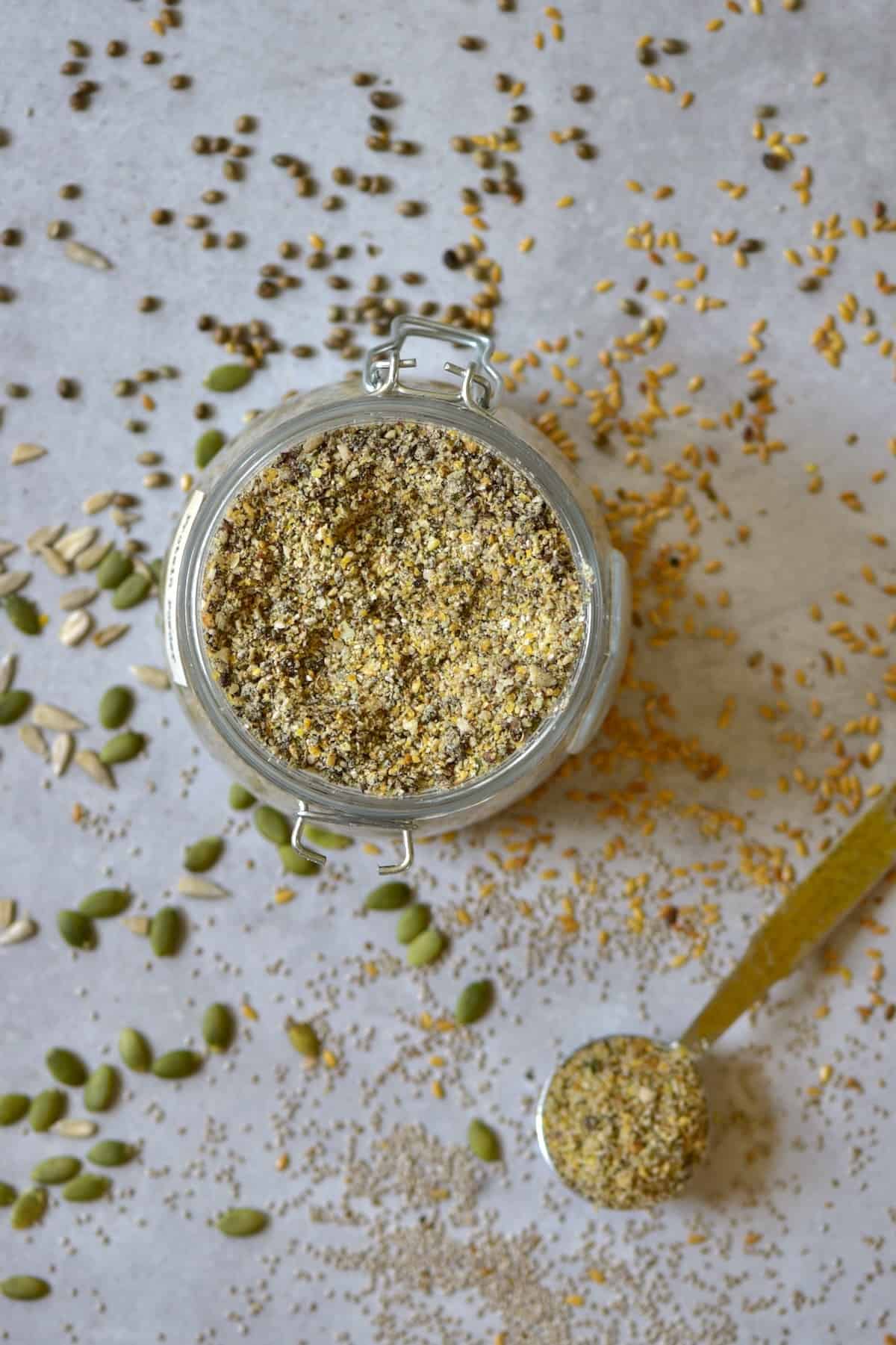
More protein-rich recipes
- Omega Seed Butter (5-Seed Butter)
- Breakfast Smoothie with Strawberries
- Cacao & Almond Protein Balls
- High-Protein Waffles
If you try this recipe, let me know how it goes in the comments below. I’d appreciate a recipe card rating and would love to see your recipe recreations – tag me on Instagram @Alphafoodie!

Simple Homemade Protein Powder
Ingredients
- 1/2 cup shelled hemp seeds also called hemp hearts (note un-shelled hemp seeds are photographed above)
- 1/2 cup chia seeds
- 1/2 cup pumpkin seeds
- 1/2 cup sunflower seeds
- 1/4 cup flax seeds
- 1/4 tsp vanilla powder optional OR 2-3 tsp cacao powder of freeze-dried berry powder.
Instructions
- Grind each seed individually in a high-speed blender or coffee/spice grinder. As a general rule:Hard seeds: Grind for 10-15 seconds or until you achieve a fine, powdery consistency. Pause and check the consistency to avoid over-processing them, as they can start turning into seed butter.Soft seeds: Grind for 5-10 seconds, and be cautious not to over-process them, or they can become gummy.
- Mix all ingredients and add the vanilla to the mixture. Store in an air-tight container.
Video
Notes
- Peanut powder (which contains 48-49 grams of protein per 100 grams)
- Pistachios (which contain 20 g protein per 100 grams)
- Pea protein isolate (which contains 80-84 g protein per 100 grams)
- Whey protein isolate (dairy-based, 90 g protein per 100 grams!)
- Whey protein concentrate (usually between 70-80g protein per 100 grams)
Nutrition
Nutrition information is automatically calculated, so should only be used as an approximation.


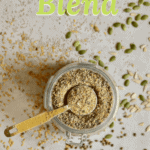









Hi
I’ve been looking for a recipe like this for a long time.
Very happy to know I have all the ingredients too
My question is…. can I freeze the mix ?
Thank you
Terri
Hi Terri,
Yes, it’s possible to freeze it for a couple of months. Make sure to use an airtight container or to take out the air from the ziplock bag if that’s what you are using. I hope this help.
Hi, thanks for sharing this amazing recipe!! I wonder if I should make these seeds cooked before grind them individually?
Lulu
Hi Lulu,
There’s no need to cook them. But if you do, make sure to cool them before grinding and don’t grind them for too long so they don’t turn into paste. I hope this helps.
Hi! Why is the shelf life only 4 weeks ? The seeds and linseed meal usually last years?
Thank you
Hi Silvia,
When you blend them, the seeds oxidize faster. That’s why I recommend using them within a few weeks. Of course, they could still be good after 4 weeks – you should be able to tell by the smell if they have gone off. I hope this helps!
Hi,
Can we roast these seeds and then grind?
Hi Nilesh,
There’s no need to roast them. But if you do, make sure to cool them before grinding and don’t grind them for too long so they don’t turn into paste. I hope this helps.
Hi there,
Thank you for this, I’m anxious to try it. However, I think it’s important to tell us why we should not overgrind the seeds, or how we are supposed to even know when they are overground… does that make sense? What will happen that we are trying to avoid?
Hi Brenda,
When over grinding the seeds, you risk them turning into butter, like hemp butter or sunflower butter. They just need to be blended into small pieces, almost flour/powder-like. But if you keep on blending, their natural oils will be released causing the mix to turn into paste and butter. I hope this helps.
Where can I find the processor you use in the video ?
Hi Amanda,
It’s a handheld blender – it’s linked on the shop page if you want to check it out – https://www.alphafoodie.com/shop/
Thank you for sharing this information. I can’t wait to try it. Iplan to use as a base for smoothies, will it work fpr that?
Please excuse the typos in the previous message. Also, I was wondering if I could use Cacao powder to switch up the flavors a bit.
Yes, of course, if wanted, add some cacao powder. Maybe first test with a small amount so you can adjust to taste – adding first a bit of cacao powder and increasing as needed.
Hi Robin,
Yes, you can add it to smoothies – use 1-2 Tbsp.
Could I blend in some yellow split peas, too?
Hi Rosalie,
The yellow split peas need to be cooked to be consumed safely. This 5-seed mix relies on seeds that can be consumed raw.
Hi.
I want to make a batch for after training.
I’m not good at quantities/measurements.
How do I know how much protein per scoop if I make a batch?
I thought it would be better rather than buying some as it’s expensive.
Hi Izzy,
One serving of 20g is 5g of protein. I hope this helps. 🙂
Thank you so much for this helpful information and recipe! I would like to confirm that 1 tablespoon has 5 grams of protein correct?
Hi there,
The nutrition shown is an estimate for the suggested serving of 20 g – so it’s 5 g of protein in 20 g of powder (about 2.5 Tbsp of this blend). I hope this helps.
I love this idea! I’m tweaking each time I make a batch. I have a problem grinding hemp seeds though. They end up coming out of the thermomix as a moist batter. Any tips on how to stop this happening?
Hi Brad,
Glad you like it! Perhaps try to blend it for shorter periods or pulse it until you get a powder consistency. Give your blender breaks in between as the heat can also play a role. Let me know if this helps.